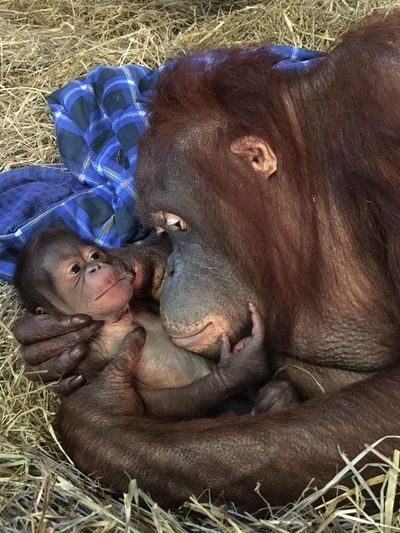Orangutan’s birth ‘a very big deal’ for National Zoo

After a record-setting four-minute labor, a 19-year-old Bornean orangutan gave birth at the National Zoo on Monday night, the first such birth at the zoo for the critically endangered species in a quarter-century.
The zoo said Tuesday that the baby, a male, was born at 8:52 p.m. The parents, female Batang, and male, Kyle, also 19, bred in January.
“It was shockingly quick,” Meredith Bastian, the zoo’s curator of primates, said Tuesday of the labor.
And the birth is “a very big deal,” she said. “This is huge. … They’re critically endangered in the wild. The next step is extinction.”
Orangutans – the word means “person of the forest” in Indonesian – have suffered extensive loss of habitat as land is cleared for plantations, Bastian said.
The baby has been seen nursing and clinging closely to his mother, and keepers are optimistic that the newborn will thrive, the zoo said in a statement.
The Great Ape House, where the baby was born, will remain closed to allow Batang a quiet place to bond with her infant.
Animal-care staff members think that Batang had successfully conceived Feb. 2, based on a human pregnancy test. The zoo announced the pregnancy June 14.
The zoo took steps to prepare Batang, and two potential female surrogates, Bonnie and Iris, for motherhood. They were trained to allow keepers to use a breast pump on them, and, with stuffed animals, to properly handle and nurse infants.
A surrogate would be tapped if Batang couldn’t properly care for her baby, Bastian said.
“Right now, the mother’s taking care of the baby, which is extremely wonderful news for us,” the curator said. “She’s a first-time mother, so she’s had to figure it out in the last few hours.”
“We will not be, unless there were to be any medical reason … pulling the baby at any point from mother,” Bastian said. “As long as the mother is taking care of the baby, that’s the most critical thing right now.”
The zoo now has seven orangutans. In the wild and in captivity, they can live into their late 50s. In the wild, their main predators are humans, clouded leopards and pythons, Bastian said.